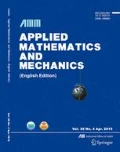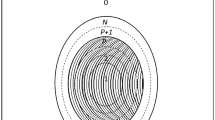Abstract
In order to apply classical micromechanics in predicting the effective prop-erties of nanocomposites incorporating interface energy, a concept of equivalent inclusion (EI) is usually adopted. The properties of EI are obtained by embedding a single inclusion with the interface into an infinite matrix. However, whether such an EI is universal for different micromechanics-based methods is rarely discussed in the literature. In this pa-per, the interface energy theory is used to study the applicability of the above mentioned EI. It is found that some elastic properties of the EI are related only to the properties of the inclusion and the interface, whereas others are also related to the properties of the matrix. The former properties of the EI can be applied to both the classical Mori-Tanaka method (MTM) and the generalized self-consistent method (GSCM). However, the latter can be applied only to the MTM. Two kinds of new EIs are proposed for the GSCM and used to estimate the effective mechanical properties of nanocomposites.
Similar content being viewed by others
References
Hashin, Z. Thin interphase/imperfect interface in elasticity with application to coated fiber composites. Journal of the Mechanics and Physics of Solids, 50(12), 2509–2537 (2002)
Duan, H. L., Wang, J., Huang, Z. P., and Karihaloo, B. L. Size-dependent effective elastic constants of solids containing nano-inhomogeneities with interface stress. Journal of the Mechanics and Physics of Solids, 53(7), 1574–1596 (2005)
Chen, T., Dvorak, G. J., and Yu, C. C. Size-dependent elastic properties of unidirectional nanocomposites with interface stresses. Acta Mechanica, 188(1/2), 39–54 (2007)
Quang, H. L. and He, Q. C. Estimation of the effective thermoelastic moduli of fibrous nanocomposites with cylindrically anisotropic phases. Archive of Applied Mechanics, 79(3), 225–248 (2009)
Huang, R. C. and Chen, Y. Q. Effect of residual interface stress on effective thermal expansion coefficient of particle-filled thermoelasticnanocomposite. Applied Mathematics and Mechanics (English Edition), 32(11), 1377–1388 (2011) DOI 10.1007/s10483-011-1508-9
Xu, Y., He, Q. C., and Gu, S. T. Effective elastic moduli of fiber-reinforced composites with interfacial displacement and stress jumps. International Journal of Solids and Structures, 80, 146–157 (2016)
Chen, Y. Q., Zhang, Z. G., Huang, R. C., and Huang, Z. P. Effect of residual interface stress on thermo-elastic properties of unidirectional fiber-reinforced nanocomposites. International Journal of Mechanical Sciences, 113, 133–147 (2016)
Hashin, Z. Thermoelastic properties of fiber composites with imperfect interface. Mechanics of Materials, 8(4), 333–348 (1990)
Dai, L. H., Huang, Z. P., and Wang, R. An explicit expression of the effective moduli for composite materials filled with coated inclusions. Acta Mechanica Sinica, 14(1), 37–52 (1998)
Garboczi, E. J. and Berryman, J. G. Elastic moduli of a material containing composite inclusions: effective medium theory and finite element computations. Mechanics of Materials, 33(8), 455–470 (2001)
Wu, Y. M., Huang, Z. P., Zhong, Y., and Wang, J. Effective moduli of particle-filled composite with inhomogeneous interphase: part I, bounds. Composites Science and Technology, 64(9), 1345–1351 (2004)
Zhong, Y., Wang, J., Wu, Y. M., and Huang, Z. P. Effective moduli of particle-filled composite with inhomogeneous interphase: part II, mapping method and evaluation. Composites Science and Technology, 64(9), 1353–1362 (2004)
Shen, L. and Li, J. Homogenization of a fiber/sphere with an inhomogeneous interphase for the effective elastic moduli of composites. Proceedings of the Royal Society of London A: Mathematical, Physical and Engineering Sciences, 461(2057), 1475–1504 (2005)
Lombardo, N. Effect of an inhomogeneous interphase on the thermal expansion coefficient of a particulate composite. Composites Science and Technology, 65(14), 2118–2128 (2005)
Sevostianov, I. and Kachanov, M. Effect of interphase layers on the overall elastic and conductive properties of matrix composites, applications to nanosize inclusion. International Journal of Solids and Structures, 44(3), 1304–1315 (2007)
Duan, H. L., Yi, X., Huang, Z. P., and Wang, J. A unified scheme for prediction of effective moduli of multiphase composites with interface effects, part I: theoretical framework. Mechanics of Materials, 39(1), 81–93 (2007)
Nguyen, T. K. and Pham, D. C. Equivalent-inclusion approach and effective medium estimates for elastic moduli of two-dimensional suspensions of compound inclusions. Philosophical Magazine, 94(36), 4138–4156 (2014)
Chen, Y. Q., Huang, R. C., and Huang, Z. P. Effect of residual interface stresses on effective specific heats of multiphase thermoelastic nanocomposites. Acta Mechanica, 225(4/5), 1107–1119 (2014)
Paulino, G. H., Yin, H. M., and Sun, L. Z. Micromechanics-based interfacial debonding model for damage of functionally graded materials with particle interactions. International Journal of Damage Mechanics, 15(3), 267–288 (2006)
Liu, H. T., Sun, L. Z., and Ju, J. W. Elastoplastic modeling of progressive interfacial debonding for particle-reinforced metal-matrix composites. Acta Mechanica, 181(1), 1–17 (2006)
Huang, Z. P. and Sun, L. Size-dependent effective properties of a heterogeneous material with interface energy effect: from finite deformation theory to infinitesimal strain analysis. Acta Mechanica, 190(1-4), 151–163 (2007)
Huang, Z. P. and Wang, J. Micromechanics of nanocomposites with interface energy effect. Handbook of Micromechanics and Nanomechanics (eds. Li, S. F. and Gao, X. L.), Taylor & Francis Group, Boca Raton, 303–348 (2013)
Huang, Z. P. and Wang, J. Micromechanics of nanocomposites with interface energy effect. Proceedings of IUTAM Symposium on Mechanical Behavior and Micro-Mechanics of Nanostructured Materials (eds. Bai, Y. L., Zheng, Q. S., and Wei, Y. G.), Springer, Beijing, 51–59 (2007)
Huang, Z. P. and Wang, J. A theory of hyperelasticity of multiphase media with surface/interface energy effect. Acta Mechanica, 182(3/4), 195–210 (2006)
Hill, R. Theory of mechanical properties of fibre-strengthened materials I, elastic behavior. Journal of the Mechanics and Physics of Solids, 12(4), 199–222 (1964)
Christensen, R. M. Mechanics of Composite Materials, John Wiley & Sons, New York (1979)
Lurie, A. I. Three-dimensional Problems of Theory of Elasticity, Interscience Publisher, New York (1964)
Dai, L. H., Huang, Z. P., and Wang, R. Explicit expressions for bounds for the effective moduli of multi-phased composites by the generalized self-consistent method. Composites Science and Technology, 59(11), 1691–1699 (1999)
Qu, J. and Cherkaoui, M. Fundamentals of Micromechanics of Solids, Wiley, Hoboken (2006)
Author information
Authors and Affiliations
Corresponding author
Additional information
Project supported by the National Natural Science Foundation of China (Nos. 11272007 and 11332001)
Rights and permissions
About this article
Cite this article
Zhang, Z., Chen, Y. & Huang, Z. Equivalent inclusions in micromechanics with interface energy effect. Appl. Math. Mech.-Engl. Ed. 38, 1497–1516 (2017). https://doi.org/10.1007/s10483-017-2276-9
Received:
Revised:
Published:
Issue Date:
DOI: https://doi.org/10.1007/s10483-017-2276-9
Key words
- interface effect
- equivalent inclusion (EI)
- Mori-Tanaka method (MTM)
- generalized self-consistent method (GSCM)




